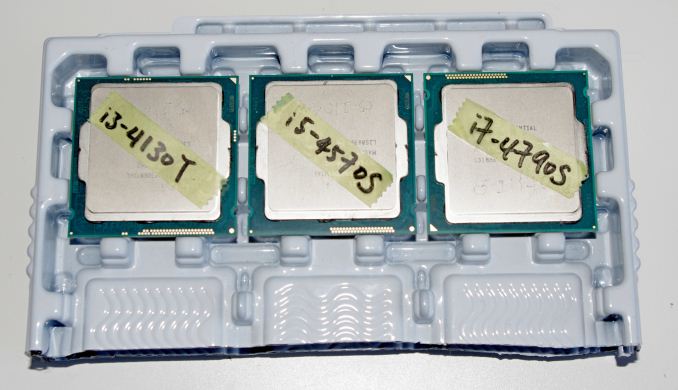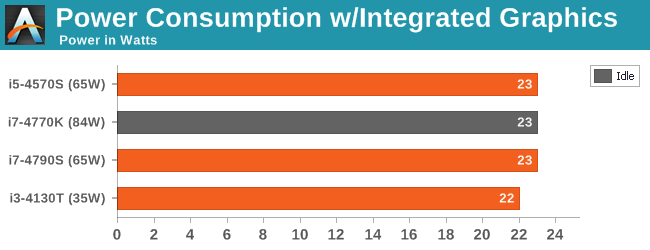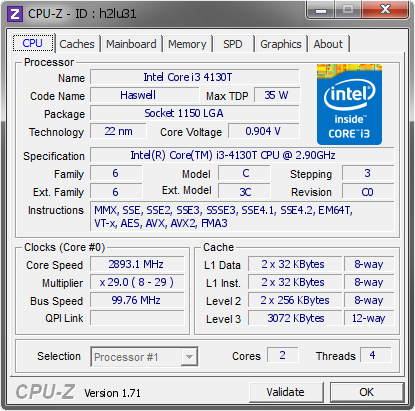Intel Haswell Low Power CPU Review: Core i3-4130T, i5-4570S and i7-4790S Tested
by Ian Cutress on December 11, 2014 10:00 AM EST
Despite being an integral part of Intel's product stack, reviews of the lower power models are few and far between. For those of us that have no interest in overclocking, the lower power parts can offer similar stock performance to the big boys but at 65W and 35W. Today we are testing three chips available from Newegg at $135, $215 and $315.
Not All CPUs are Alike
While Intel's CPU naming scheme is finally starting to make sense to home system builders, their product stack consists mainly of generic numbers in either Celeron, Pentium, i3, i5 or i7 format unless someone sits down and explains the trend to the individual. These models are clearly defined whereby a bigger number tends to mean more frequency. With this general stack of names, there are sometimes models that come with extra letters. Overclockers already know the K and the X models as having their multiplier unlocked for extra potential, but for other CPUs we have T and S destinations. (Xeons also use the letter L, and mobile chips have H/Y/U.)
Simply put, T is used for 35W/45W models and S is for 65W models. The S models tend to have similar single core performance to their normal cousins, but reach 65W by reducing the multicore frequency when the CPU is loaded. The T models reduce both single core and multicore frequency to hit their 35W or 45W, but tend to be a little more esoteric in their position in the stack.
In general there are two ways to reduce the TDP on a CPU. We can either reduce frequency (easy) or reduce voltage (difficult). Reducing the voltage results in more of a change in power consumption, but the best way to tackle this is when Intel performs its binning process.
When a manufacturer creates a wafer of CPUs, these have to be tested for accuracy of calculations, functions, and the voltage/frequency response. It is this latter characteristic which matters most when determining what product in the stack it should be. The units with the highest frequency for the lowest voltage (on a scale) tend to be reserved for the fastest processors or Xeons. Note that it is not only a single data point being tested, but a whole scale from low frequency to high frequency. The unit has to match an entire line to be sufficient for that designation. Where the low power CPUs come in is that they follow a particular line at a potentially lower voltage range than expected.
There have been reports of the regular branding of CPUs being reduced in frequency and matching the stability of the S/T processors. That is entirely possible, as a unit can be a member of many bins at the same time. At the end of the day, when you purchase a lower power processor, you are essentially guaranteed that level of performance and TDP by the processor manufacturer.
The Product Stack
To represent Intel's Haswell line-up, I want single out where the S and T processors stack up against their normal counterparts. Thus is made somewhat difficult by the Haswell refresh earlier this year which caused a frequency bump in most models, but both pre-refresh and post-refresh processors are still up for sale in most markets.
| Intel Haswell T CPUs | ||||||
| Cores / Threads | TDP | L3 | Base Frequency |
Turbo Frequency |
OEM Price | |
| i3-4130T | 2 / 4 | 35W | 3MB | 2900 | $122 | |
| i3-4150T | 2 / 4 | 35W | 3MB | 3000 | $117 | |
| i3-4160T | 2 / 4 | 35W | 3MB | 3100 | $117 | |
| i3-4330T | 2 / 4 | 35W | 4MB | 3000 | $138 | |
| i3-4350T | 2 / 4 | 35W | 4MB | 3100 | $138 | |
| i3-4360T | 2 / 4 | 35W | 4MB | 3200 | $138 | |
| i5-4460T | 4 / 4 | 35W | 6MB | 1900 | 2700 | $182 |
| i5-4570T | 2 / 4 | 35W | 4MB | 2900 | 3600 | $192 |
| i5-4590T | 4 / 4 | 35W | 6MB | 2000 | 3000 | $192 |
| i5-4670T | 4 / 4 | 45W | 6MB | 2300 | 3300 | $213 |
| i5-4690T | 4 / 4 | 45W | 6MB | 2500 | 3500 | $213 |
| i7-4765T | 4 / 8 | 35W | 8MB | 2000 | 3000 | $303 |
| i7-4770T | 4 / 8 | 45W | 8MB | 2500 | 3700 | $303 |
| i7-4785T | 4 / 8 | 35W | 8MB | 2200 | 3200 | $303 |
| i7-4790T | 4 / 8 | 45W | 8MB | 2700 | 3900 | $303 |
| Intel Haswell S CPUs | ||||||
| Cores / Threads | TDP | L3 | Base Frequency |
Turbo Frequency |
OEM Price | |
| i5-4430S | 4 / 4 | 65W | 6MB | 2700 | 3200 | $182 |
| i5-4460S | 4 / 4 | 65W | 6MB | 2900 | 3400 | $182 |
| i5-4570S | 4 / 4 | 65W | 6MB | 2900 | 3600 | $192 |
| i5-4590S | 4 / 4 | 65W | 6MB | 3000 | 3700 | $192 |
| i5-4670S | 4 / 4 | 65W | 6MB | 3100 | 3800 | $213 |
| i5-4690S | 4 / 4 | 65W | 6MB | 3200 | 3900 | $213 |
| i7-4770S | 4 / 8 | 65W | 8MB | 3100 | 3900 | $303 |
| i7-4790S | 4 / 8 | 65W | 8MB | 3200 | 4000 | $303 |
If we do direct comparison with a few of the S processors with their non-S counterparts, we see their main difference is just the multicore frequency to drive the TDP down.
| Intel Haswell S CPU Comparison | ||||||
| Cores / Threads | TDP | L3 | Base Frequency |
Turbo Frequency |
OEM Price | |
| i5-4590S | 4 / 4 | 65W | 6MB | 3000 | 3700 | $192 |
| i5-4590 | 4 / 4 | 84W | 6MB | 3300 | 3700 | $192 |
| i7-4770S | 4 / 8 | 65W | 8MB | 3100 | 3900 | $303 |
| i7-4770 | 4 / 8 | 84W | 8MB | 3400 | 3900 | $303 |
With the T processors, we see a more aggressive trend especially with the i7 range.
| Intel Haswell T CPU Comparison | ||||||
| Cores / Threads | TDP | L3 | Base Frequency |
Turbo Frequency |
OEM Price | |
| i3-4160T | 2 / 4 | 35W | 3MB | 3100 | $117 | |
| i3-4160 | 2 / 4 | 54W | 3MB | 3600 | $117 | |
| i7-4770T | 4 / 8 | 45W | 8MB | 2500 | 3700 | $303 |
| i7-4770 | 4 / 8 | 84W | 8MB | 3400 | 3900 | $303 |
The i7 35W processors have always been a fascination of mine (much like the 65W 12-core Xeon we reviewed earlier in the year). Ultimately these are best for work flow that can use multicore processing but the code has significant memory delays. This reduces the idle time per core and uses less power.
The purpose of this review is to see how these processors compare to those we have already tested. We currently have a good spread of the Haswell range, and all the results can be found in our online benchmark comparison database, Bench.
Test Setup
| Test Setup | |||||
| Processor | |||||
| Intel Core i3-4130T | 35W | 2C/4T | 2.9 GHz | ||
| Intel Core i5-4570S | 65W | 4C/4T | 2.0 GHz / 3.0 GHz | ||
| Intel Core i7-4790S | 65W | 4C/8T | 2.7 GHz / 3.7 GHz | ||
| Motherboards | ASUS Z97 Pro MSI B85M Eco |
||||
| Cooling | Cooler Master Nepton 140XL | ||||
| Power Supply | OCZ 1250W Gold ZX Series | ||||
| Memory | G.Skill RipjawsZ 4x4 GB DDR3-1600 9-11-9 Kit | ||||
| Memory Settings | 1600 9-11-9-27 1T tRFC 240 | ||||
| Video Cards | MSI GTX 770 Lightning 2GB (1150/1202 Boost) | ||||
| Video Drivers | NVIDIA Drivers 337 | ||||
| Hard Drive | OCZ Vertex 3 256GB | ||||
| Optical Drive | LG GH22NS50 | ||||
| Case | Open Test Bed | ||||
| Operating System | Windows 7 64-bit SP1 | ||||
Load Delta Power Consumption
Power consumption was tested on the system while in a single MSI GTX 770 Lightning GPU configuration with a wall meter connected to the OCZ 1250W power supply. This power supply is Gold rated, and as I am in the UK on a 230-240 V supply, leads to ~75% efficiency > 50W, and 90%+ efficiency at 250W, suitable for both idle and multi-GPU loading. This method of power reading allows us to compare the power management of the UEFI and the board to supply components with power under load, and includes typical PSU losses due to efficiency.
We take the power delta difference between idle and load as our tested value, giving an indication of the power increase from the CPU when placed under stress.

Power consumption for our i3 and i5 samples were near on the mark, whereas the i7-4790S scored 102W from idle to AVX. This is more than the i7-4770K, which might come across as a bit alarming.
We also have some full system power draw numbers from the MSI B85M ECO review, while using a Rosewill Silent Night 500W Platinum power supply. These are still in the 5% power used range for the unit, so efficiency is still around 70-80%.

Load Delta Temperature on Intel Stock Cooler
At request from some of our readers on Twitter, we also measured the temperature delta from idle to load on the stock Intel cooler.













76 Comments
View All Comments
dave_the_nerd - Thursday, December 11, 2014 - link
I have a custom build SFF system with a 4670T, so... yay!Dahg - Thursday, December 11, 2014 - link
One of the really interesting aspects of the i3-4130T processors is that they work on workstation motherboards with ECC memory (unlike the i5 and i7). Perfect for building a NAS instead of using the low power Xeons. When buying an i3, make sure whether you'll be getting one with or without integrated GPU.Mickatroid - Thursday, December 11, 2014 - link
I recently built a system with a an i5-4690s. I still used a decent cooler (Scythe Big Shuriken 2). Why the lower TDP part? It is for my workshop. It gets hot in there and it is a machine that I want working reliably for a very long time. The S processor was an obvious choice. I ended up still less than 45degrees above ambient running IntelBurnTest. Very nice. Dust filtering is provided by an automotive 'pod' filter. Just thought it worth mentioning since it is a use case that is not quite the same as those mentioned at the end of the (interesting thanks) review.Gigaplex - Thursday, December 11, 2014 - link
Here we have a review of low power CPUs, and there's pretty much no analysis on the actual power usage. There's one delta test that shows the supposedly low power CPU drawing way more power than it should, with no follow up tests. What I want to know is, how much power do I actually save with these chips.alacard - Thursday, December 11, 2014 - link
That'd be zero. Here's your answer from a REAL review: http://www.xbitlabs.com/articles/cpu/display/core-...Anandtech, get your act together for Christ's sake.
CountDown_0 - Saturday, December 13, 2014 - link
I don't want to play the devil's advocate, but... Do you seriously think xbitlabs's review is a real one? They wrote 8 pages about low TDP processors (where the "T" stands for thermal) and they didn't bother to check the temperatures. Nor noise, for that matter, and considering that these processors are an obvious candidate for mini ITX systems, where both temperature and noise are an issue, I wouldn't say it is a real review. Ok, noise might be less important, but holy crap, these CPUs have a lower thermal design and you don't even have a look at temperatures? And no, checking the power is not enough. The relationship between power and temperature is not so linear.But I have to say they did a very good job by checking the voltage, revealing that these CPU's aren't binned. Which is surprising, in my opinion, as it contradicts both this review and common sense.
Anyway I have to agree with you that AT's review is also disappointing. Apart from the choice of a huge PSU, whose motivation (uniformity across all tests) does at least make sense - and anyway I am interested in the difference between processors, not so much in absolute values, so it isn't too bad - they have taken a performance-centric approach. Checking the performance is ok, but then you also have to check power and temperatures (ok, I'll leave noise aside), and they didn't do too much about this either. They have only one graph about temperatures. I am really surprised to see that the i7 4790s (65W) is 7° hotter than the the 4770k (84W), and there isn't a single word about this. They just say that the power consumption is also higher, and it might be "a bit alarming". Well, I'd say it is more than a bit alarming: the CPU is clearly slower, and then it consumes more and gets hotter??? Maybe Intel is binning CPUs after all, it's just the other way around: for S models they choose the crappiest ones! :-D Seriously, that demands further investigation. As things look right now, buying an S model wouldn't make sense.
In the end, both reviews leave my question unanswered: is it a good idea to choose an S model for a mini-ITX system to keep temperatures down? I think I will have to use pcpartpicker and some forums to figure out. But it is a very long, slow and painful research, and I wish I could have spared it.
alacard - Saturday, December 13, 2014 - link
I'd say that comparison between xbitlab and anandtech's reviews is entirely valid given that Anandtech's review is more like an empty shell of a partial review whereas xbitlabs actually digs down into the chips and analyzes them. We're in agreement that more attention wasn't paid to the power, temperature, noise aspect in either review though. I'm not sure what happened but those three metrics used to be standard, and now it's like we're lucky to even get them and when we do they're often half-assed.Take a look at Anandtech's review here and you'll notice more than half of the words in it are dedicated to explaining what the benchmark programs are good for testing. Take those useless paragraphs out and you're left with piratically nothing: a tiny bit of analysis and a smattering of charts. This is one of the laziest writeups i can recall seeing on this site. It provides almost no insight and sheds almost no light on the items it's analyzing.
Anandtech used to be the gold standard in tech analysis, and now they're no longer even the first site i visit when an embargo lifts on a highly anticipated recently released piece of tech. Being the best was their crown to lose, and i'm afraid they've lost it. This "review" is just another nail in the coffin.
ruthan - Friday, December 12, 2014 - link
Finally someone cares about nature and my ears, results are better than i expected, im using those S and T procesors for last 4 years and im completely happy with them. Even todays low power Xeons are great.happycamperjack - Friday, December 12, 2014 - link
Could you guys add more CPU intensive gaming benchmarks next time such as Crysis 3, Dragon Age Inquisition and Assassin's Creed Unity? Thanks.Beaver M. - Friday, December 12, 2014 - link
I have been using a i7-4770S for 8 months and its really fast enough while not drawing too much power (I still get it over 80W, if I use Prime95). Very important to me to limit the power, since mine runs on battery.What I dont like however is that the T and S are also not soldered to the heatspreader. That means they get far too hot for small coolers. I had to delid mine and use liquid metal paste between heatspreader and die. I got 20°C less through that. Now the small cooler can run much more silent and I still only get 65°C max. On top of that, since it runs much cooler, it also draws about 5 to 10 Watts less, depending on what it does.